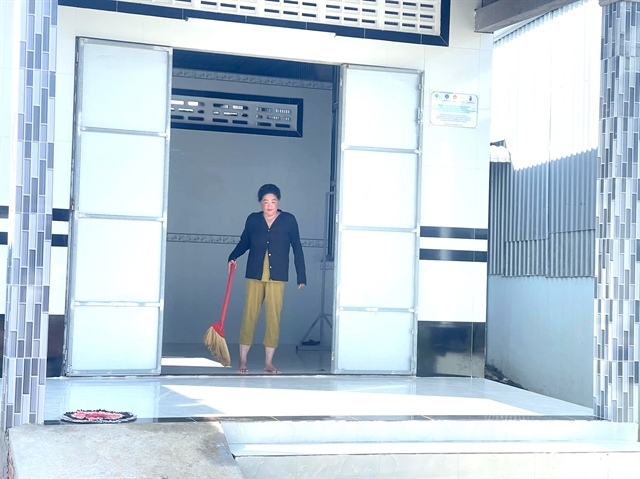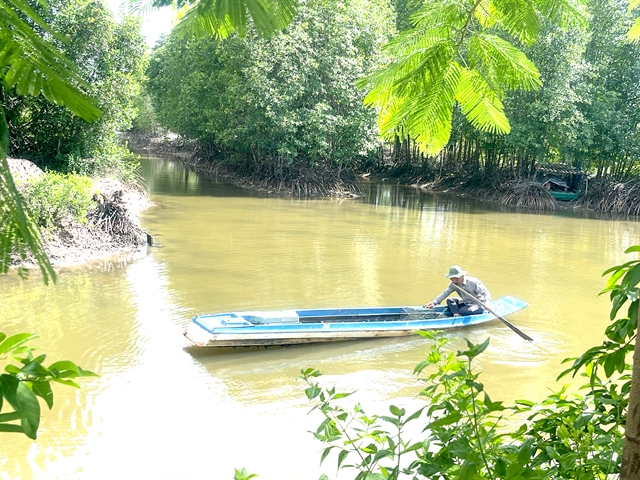 |
| Lê Thị Liên sweeps the floor in her new home. Having a solid house to live in has been her family’s dream for a long time. — VNS Photo Thu Trang |
Thu Trang
CÀ MAU — Lê Thị Liên, 42, is so happy to live in her newly-built house, which has been a long-term dream of her family.
Earlier, her previous home, in Khánh Lâm Commune, U Minh District, the southern province of Cà Mau was seriously rundown and unsafe.
Her family remember terrible times and have sad memories from rainy and stormy seasons, when leaks in the roof of her home left it partially submerged almost all of the time.
Liên is a housewife and all of her family’s income depends on her husband’s insecure work.
Her first daughter had to quit school at grade 7, while her second son had to leave school at grade 4 because of their poor health and the family’s living conditions.
“Income from my husband’s fishing is not enough for daily use, so we did not even dare to dream for a solid house,” said Liên.
Now, with support from sponsors and local authorities, Liên’s desire for a safe and dry home has been fulfilled.
Liên is among more than 20,000 poor people who received 4,966 solid houses from the programme ‘Improving the resilience of vulnerable coastal communities to climate change-related impacts in Việt Nam’ known as Project GCF.
The project started in 2017 across Nam Định, Thanh Hóa, Quảng Bình, Thừa Thiên-Huế, Quảng Nam, Quảng Ngãi and Cà Mau provinces.
Its total budget is US$41.9 million, of which monies from the Green Climate Fund accounted for $29.5 million, the Vietnamese Government contributed $10.8 million and it was topped up with a fund from the United Nations Development Programme (UNDP), $1.6 million.
The objective of the project is to improve the resilience of vulnerable coastal communities to climate change-related impacts in Việt Nam through safe housing, to protect vulnerable communities from increased flooding and storms, ensure robust mangrove coverage to provide a natural buffer between coastal communities and the sea and to improve climate risk information to guide climate-resilient and risk-informed planning.
To date, the project’s results include 4,966 resilient homes constructed, 4,260ha regenerated mangroves installed and more than 1.1 million tonnes of carbon dioxide avoided and more than 62,000 people with access to climate change and resilience information.
Safe houses were built in Cà Mau Province in compliance with the Ministry of Construction’s housing standards, added with resilient features, suited to the landscape and the way of life of coastal residents.
Each house is designed with a peak height of 4m, a usable area of 18-40sq.m and can withstand a wind speed of 118-133km per hour.
The house’s foundation is at least 0.5m higher than the highest water level.
Each house is worth VNĐ80 million ($3,100), of which half is supported by the project and the remainder comes from the local budget.
Hope
Lê Văn Sử, Deputy Chairman of the Cà Mau Province People’s Committee, said that Cà Mau was the latest province to join the project, starting from the beginning of 2024.
“With determination to overcome difficulties of the project management board, the provincial authorities and beneficiary families, the project has so far completed the goal of building 425 safe houses in Cà Mau,” said Sử.
He said that people in coastal communes of the province still have to cope with storms, high tides and harsh conditions of climate change every year.
Support from the Project GCF has helped a large number of poor households have safe accommodation.
“With a coastline of 254km, 41 coastal and near-coastal communes and towns, Cà Mau has many poor households who do not have houses,” he said.
Sử hopes that ministries, donors and community will continue to partner with the the province to support poor households, allowing them to stabilise their lives and be safe from natural disasters.
“Households that have been helped to build houses must cherish the affection and support, use it effectively, strive to escape poverty, not only to have safe housing but also to have a prosperous and happy life,” he said.
Ramla Khalidi, UNDP Resident Representative in Việt Nam, emphasised that the houses had made the dream for the poor in coastal areas come true.
This was their motivation to confidently develop their livelihoods, she said.
A house was a valuable asset for individuals and families. Therefore, building safe houses was the foundation for enhancing the ability to adapt to climate change of households living in coastal areas of Việt Nam, she said.
Livelihood support
 |
| A farmer checks his ecological shrimp farming pond under the mangrove canopy in Viên An Đông Commune, Ngọc Hiển District, Cà Mau Province. — VNS Photo Thu Trang |
Nguyễn Hữu Quyền, Deputy Director of the Legal Inspection Division of the Cà Mau Forest Protection Department and also project supervisor, said that Cà Mau is the only province in the country that has three sides bordering the sea, with a length of 254km, often faces landslides and salinity intrusion.
“With an area of 3,168ha of new planting and additional restoration planting of forest supported by the Project GCF along the province’s coastline, it has significantly contributed to improving the ability to protect against waves and protect sea dikes,” he said.
Specifically, 1,389ha of additional planting and restoration forest under the charge of the Đất Mũi Protective Forest Management Board have created a ‘green wall’ defending 12km of coastline, 2,000ha of ecological shrimp farming under the forest canopy, and supported the lives of 577 local households.
“Cà Mau has favourable conditions for aquaculture development and is the locality with the largest shrimp farming area in the country with nearly 280,000ha,” said Quyền.
Currently, Cà Mau has nearly 40,000ha of ecological shrimp farming under the forest canopy, most farms concentrated in Ngọc Hiển District with nearly 23,000ha. Of which, about 20,000ha of shrimp area are certified according to international standards.
In recent years, the project has supported 11 ecological shrimp farming models under the mangrove canopy for 978 households to achieve certification according to international standards, supplying exports and bringing farmers a stable income.
In 2023-2024, among the households implementing the aquaculture model under the forest canopy, the project selected 500 households in Nguyễn Huân Commune, Đầm Dơi District to participate in the aquatic traceability system for ecological shrimp.
“The results have increased the economic value of shrimp farming activities, while protecting mangrove forest resources,” said Quyền.
Aquaculture under the forest canopy is a form of farming associated with forest protection with many farmed species such as shrimp, fish, crabs and snails.
Today, this model is also considered a measure to absorb carbon and reduce greenhouse gas emissions in line with the green development trend in the world, bringing stable income to local people,” he said.
Việt Nam is considered one of the six countries at most extreme risk to climate change. According the Ministry of Natural Resources and Environment (MoNRE), climate change has contributed to temperature increases of more than 0.5 degree Celsius and a 20cm rise in sea level over the past 50 years in Việt Nam.
Extreme climate events also have been increasing. Over the last two decades, Việt Nam has reported 226 extreme weather events, which have killed on average 286 people per year and caused annual economic losses of $2 billion, according to the MoNRE.
In Việt Nam, more than 500,000 people live within 200m of the coast. Their homes are usually affected by typhoons and many of them live in unsafe housing, in part due to rapid urbanisation and persistent poverty.
The absence of rigorous climate risk information places considerable limitations on climate-resilient planning and adaptation investments. Access to climate damage and loss data and early warning information helps communities to reduce disaster risk and build more sustainable socio-economic development in the context of climate change. — VNS
- Reduce Hair Loss with PURA D’OR Gold Label Shampoo
- Castor Oil Has Made a “Huge” Difference With Hair and Brow Growth
- Excessive hair loss in men: Signs of illness that cannot be subjective
- Dịch Vụ SEO Website ở Los Angeles, CA: đưa trang web doanh nghiệp bạn lên top Google
- Nails Salon Sierra Madre
 VnExpress News The News Gateway of Vietnam
VnExpress News The News Gateway of Vietnam





